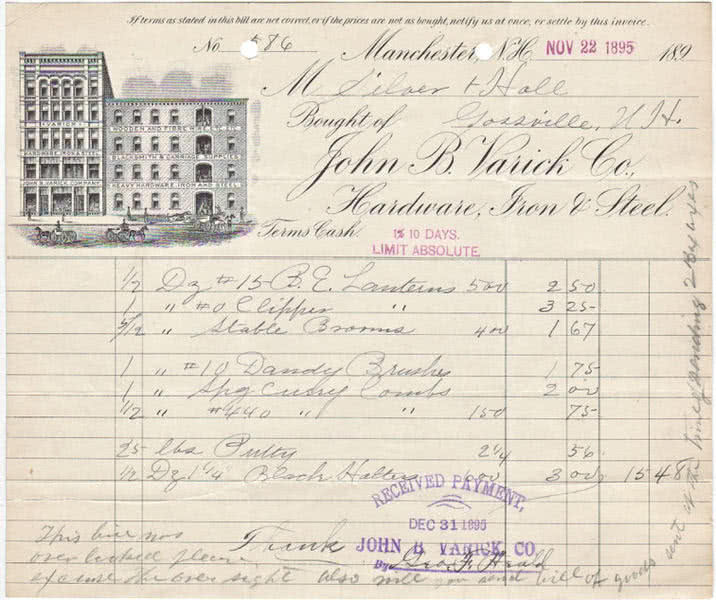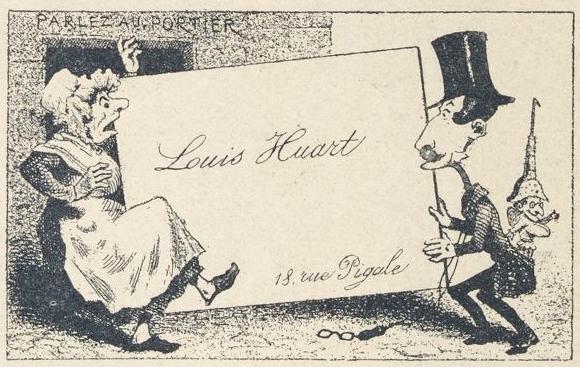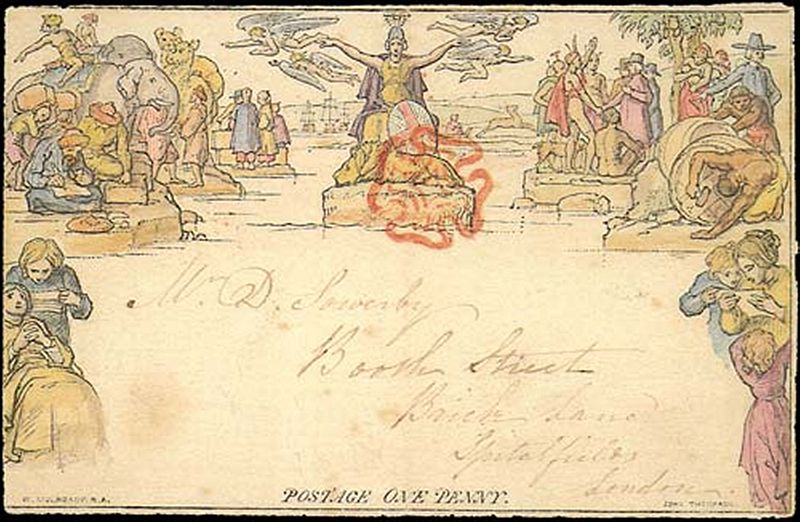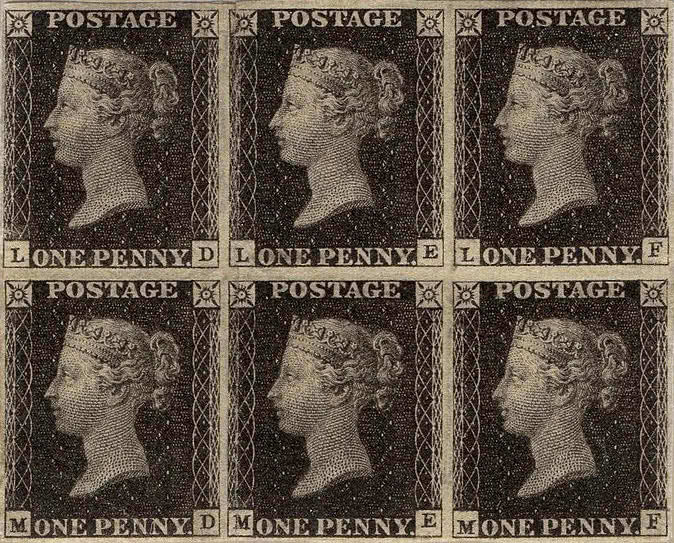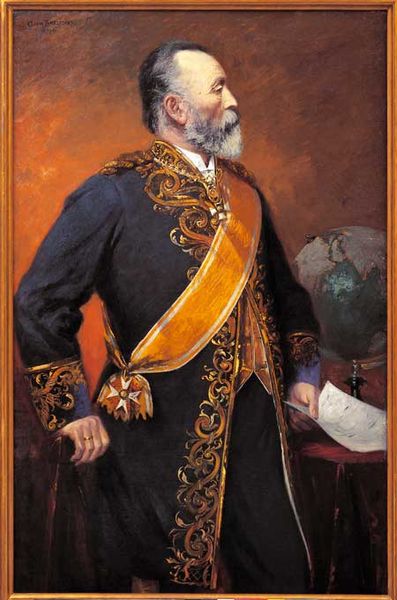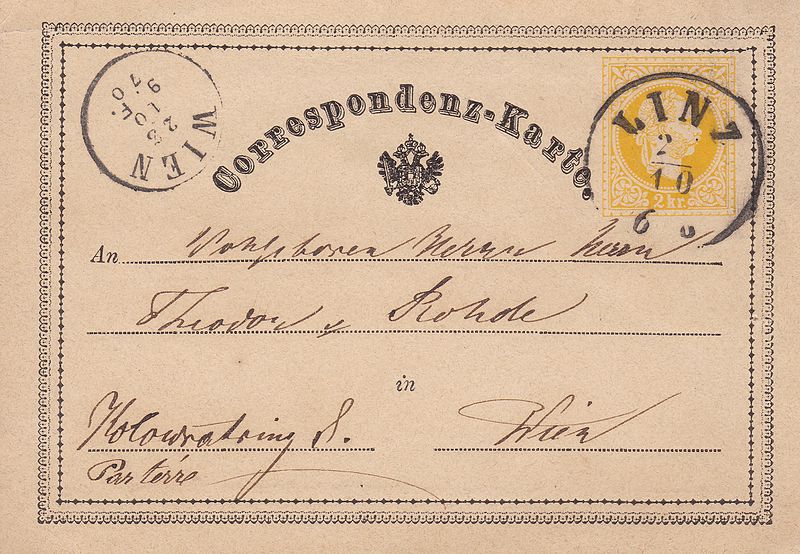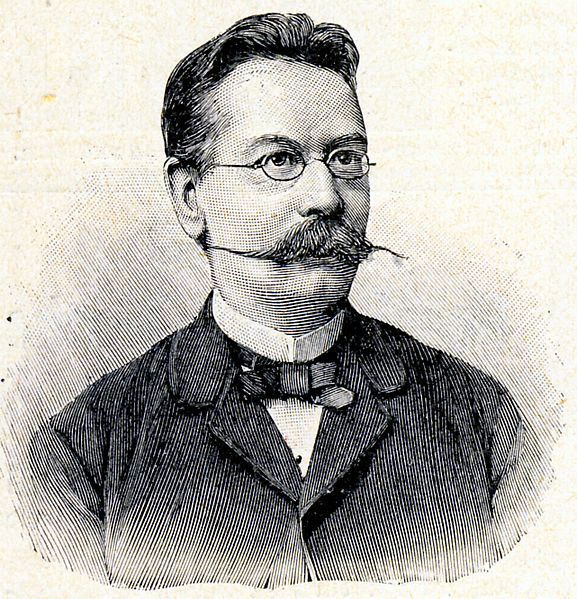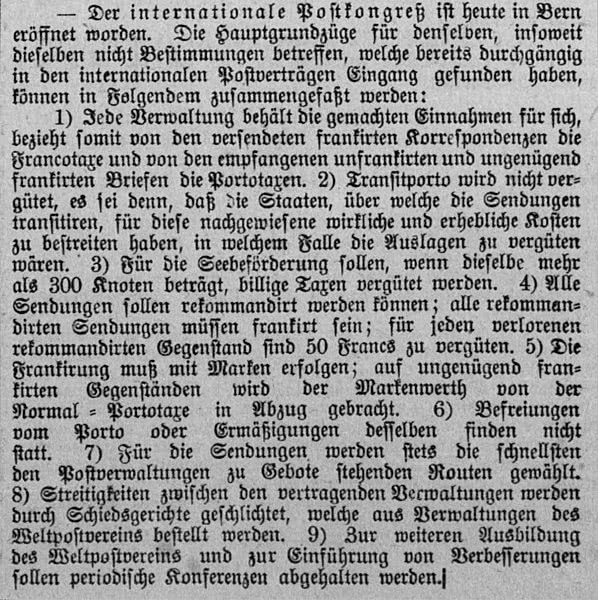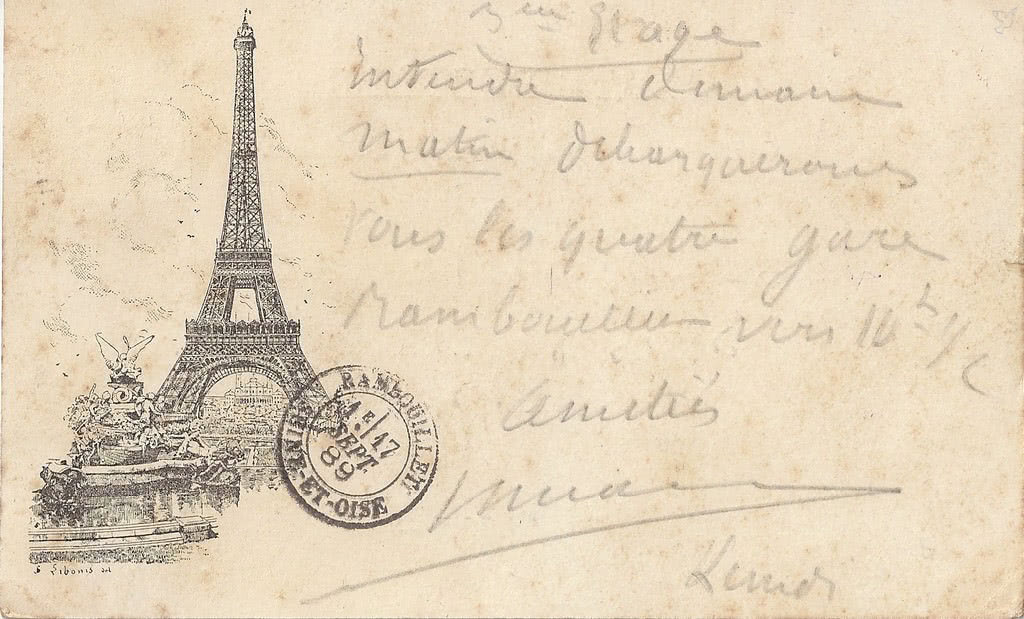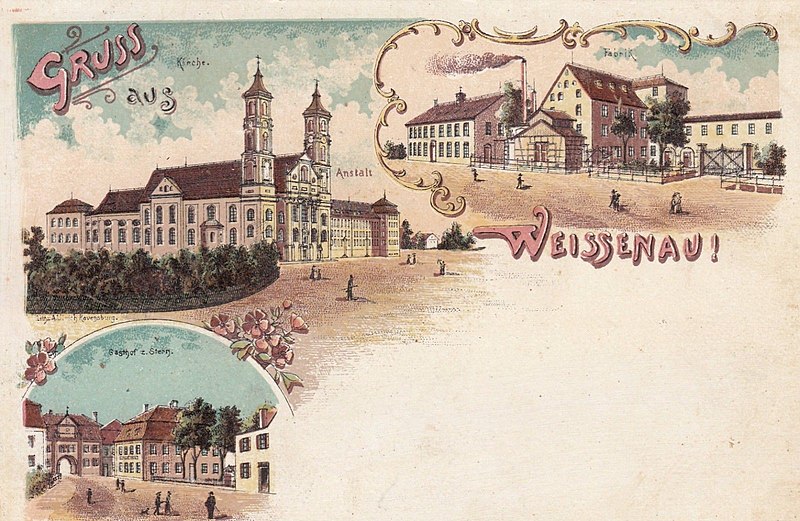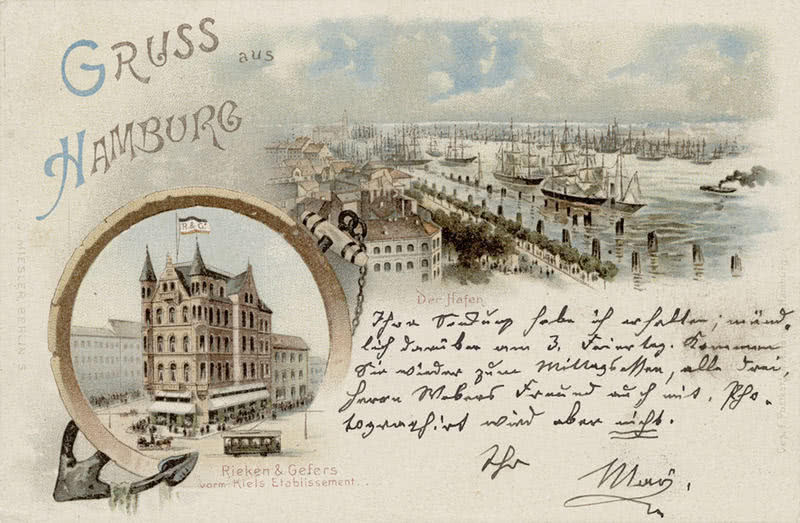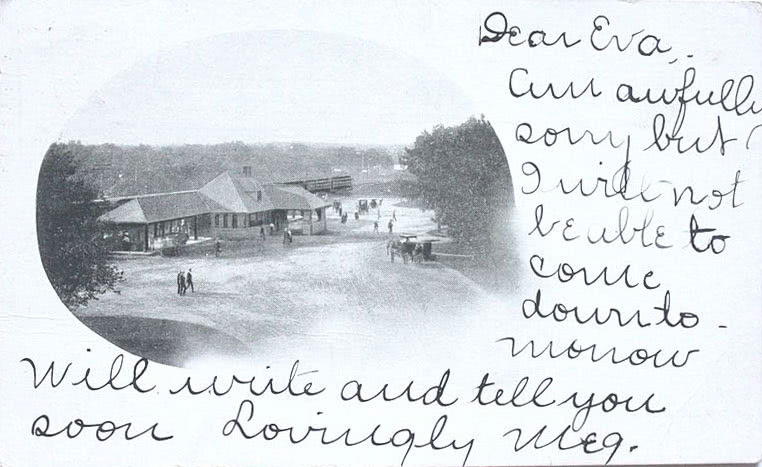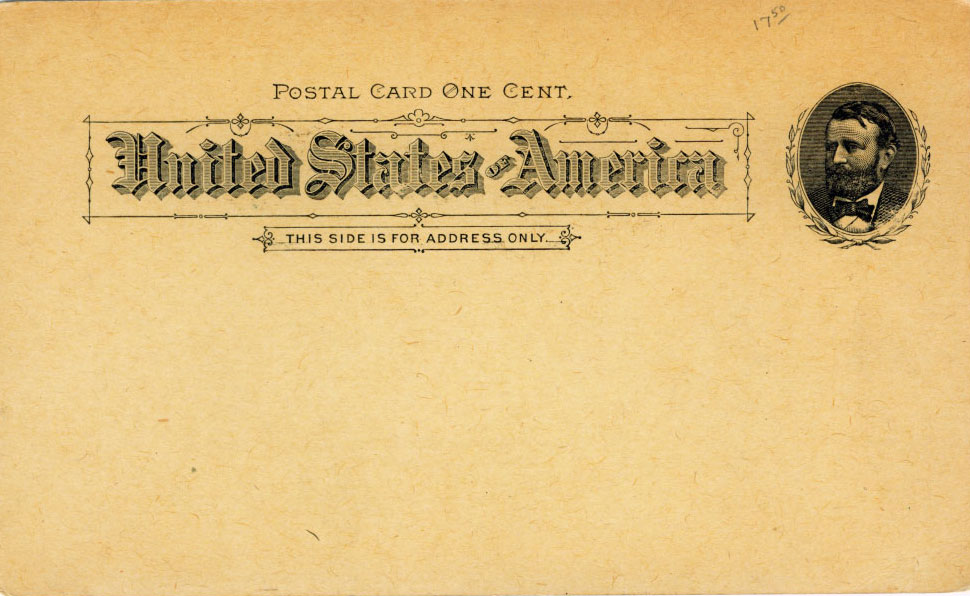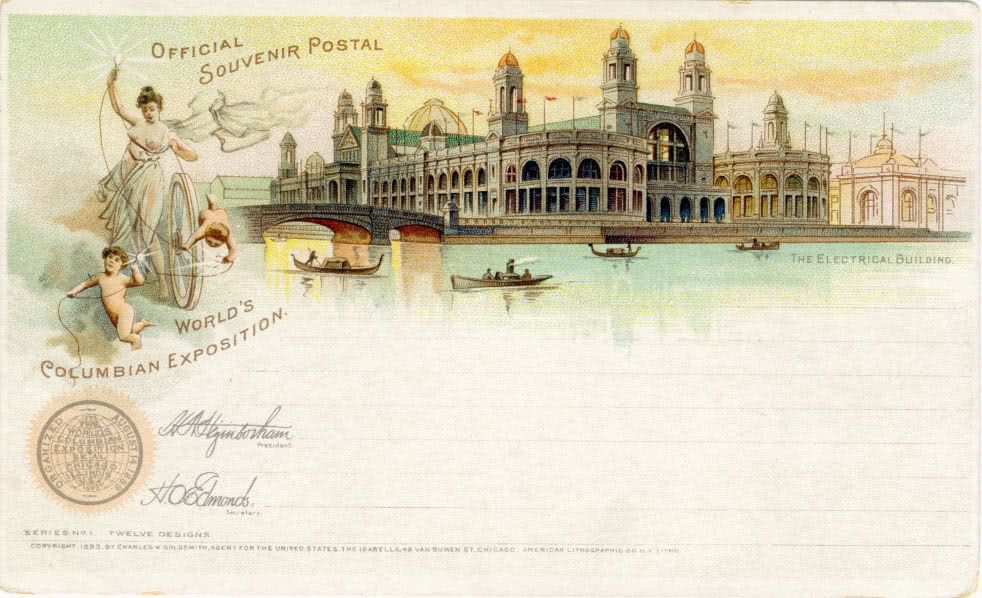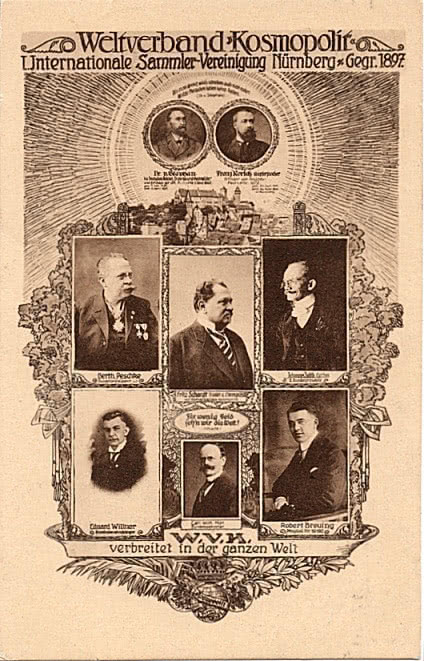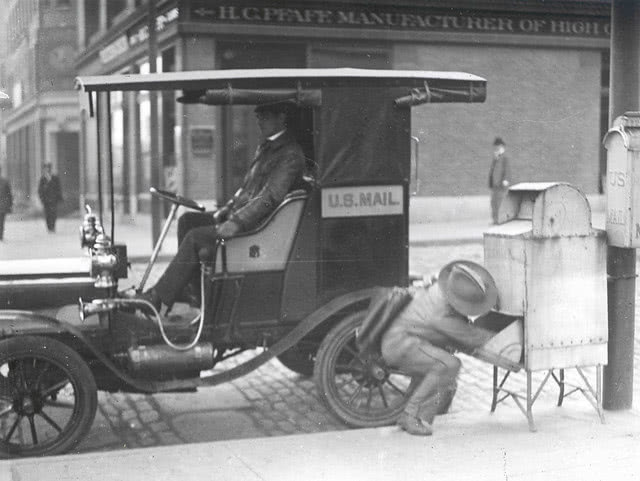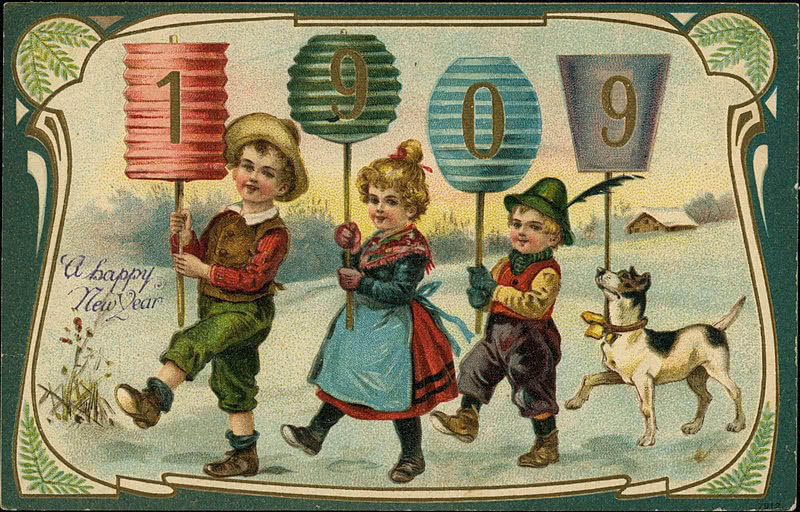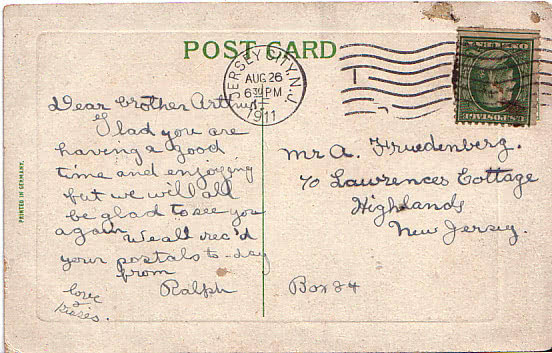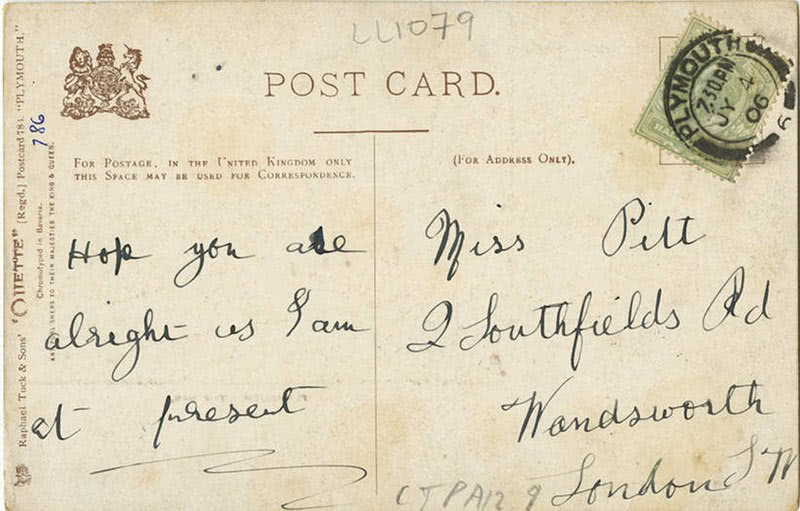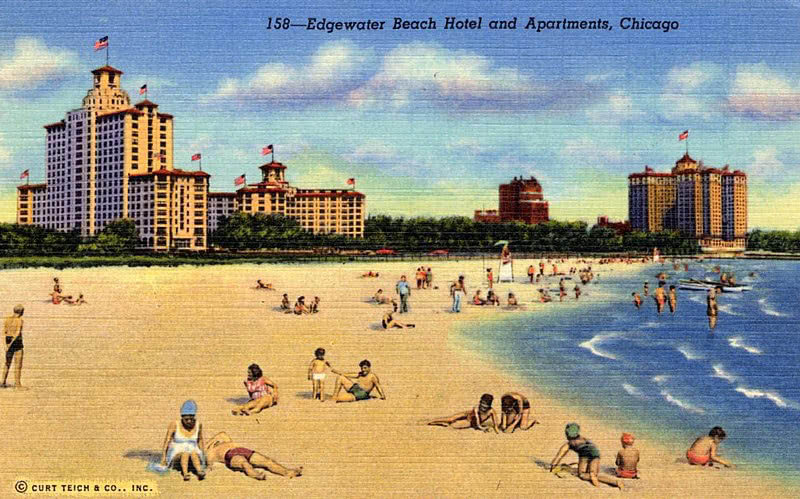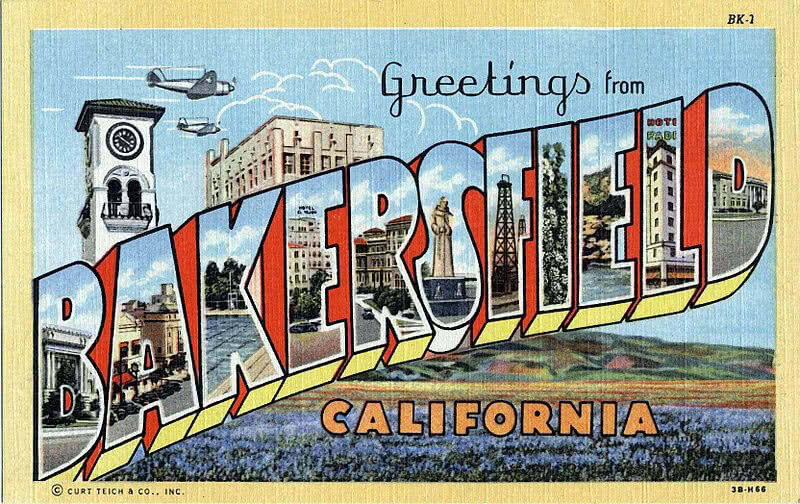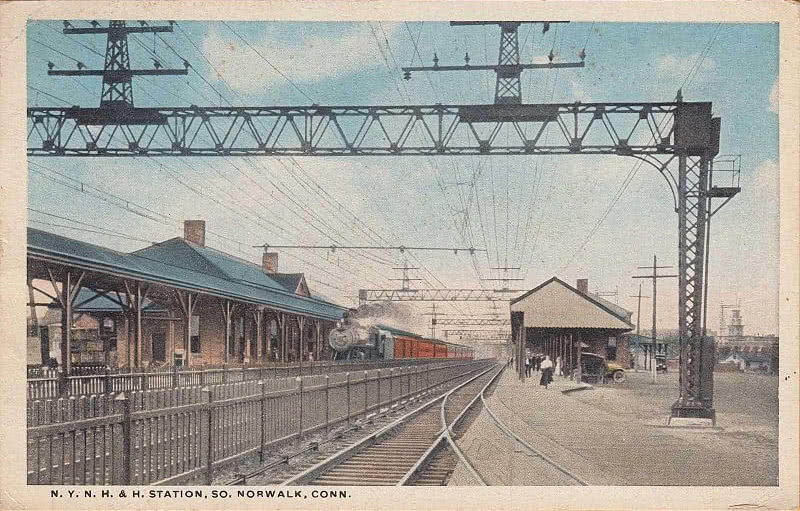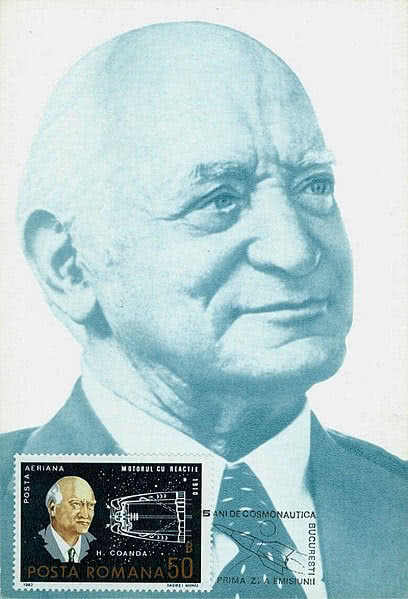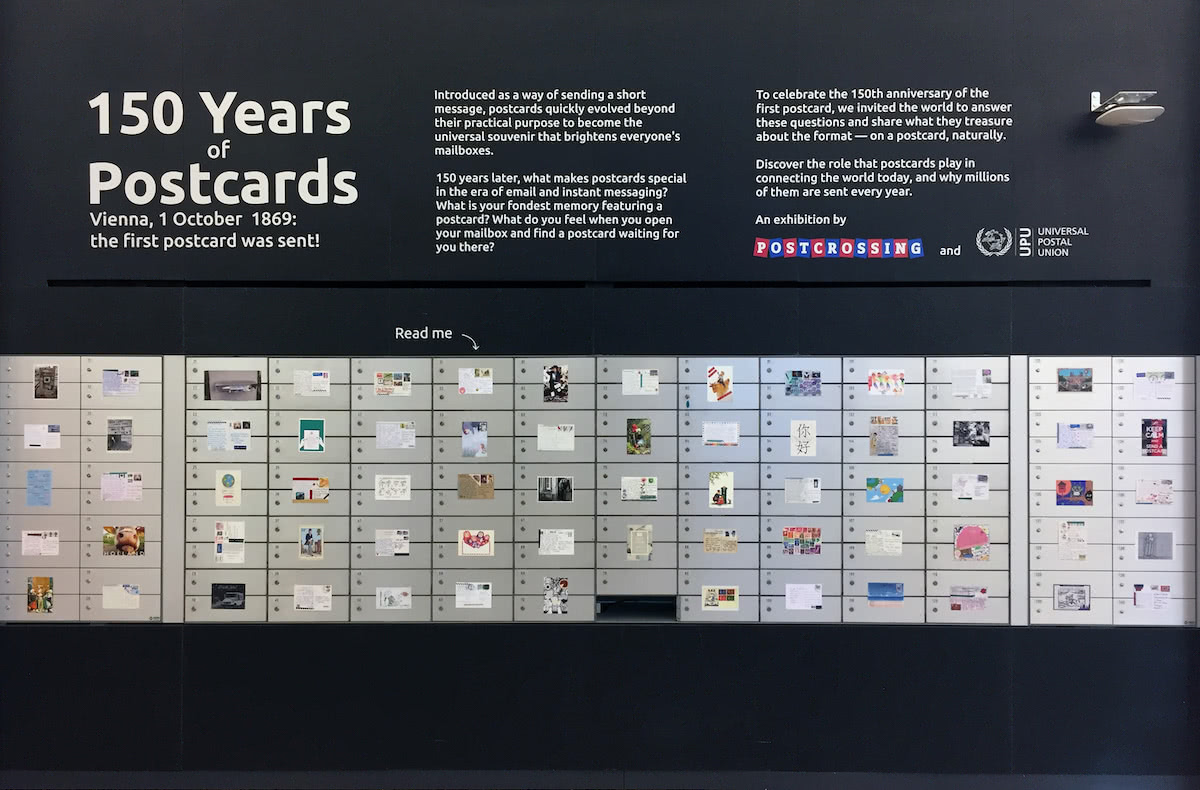History of postcards
Tracing back the origins of the picture postcard is difficult because postcards were not simply invented — instead, they evolved. Their history is inevitably linked with the development of the postal service, but also features innovations in printing and photography, daring proposals... and even a 300-meter tower!
We try to chronicle the history of postcards through a timeline of relevant events, going back a few centuries to provide the context that culminated in postcards being officially issued and recognized by a postal operator, on October 1st 1869.
17-19th century
Following the popularization of printing presses, visiting cards, bill heads, writing paper and other types of paper ephemera started to have illustrations on them, often with delicate engravings and tasteful designs.
Already in 1777, French engraver Demaison published in Paris a sheet of cards with greetings on them, meant to be cut and sent through the local post, but people were wary of servants reading their messages... so the idea was not very well received.
1840
A postal reform in the UK unified the cost of domestic mail delivery to 1 penny per envelope, to be prepaid by the sender. The proposals of Sir Rowland Hill also included that the pre-payment was to be made by issuing printed sheets of adhesive stamps. The Penny Black, the world's first adhesive postage stamp, made its debut in May 1840.
Simultaneously, decorated prepaid letter sheets (similar to today's aerograms) were also put on sale by the post office. These were designed by William Mulready and showed Britannia with a lion at her feet, sending mail messengers to all parts of the world. Though this particular design turned out to be unpopular and often ridiculed, this was the first postal stationery item issued by the post office that had decorations on the outside. They were replaced the following year by plain pink envelopes, with a printed 1 penny stamp on the corner.
Already that year, Theodore Hook Esq, a British writer, mailed himself a caricature of post office workers, shown to be writing mail in order to sell more stamps. Most likely mailed as a joke (and delivered against the post office regulations of the time), this could probably be the earliest record of a postcard being sent through the mail.
A few years later, in 1843, Sir Henry Cole produced the first Christmas greeting card, a drawing of himself and his family. This was the year in which Charles Dickens A Christmas Carol was published.
1861
In late February, the US Congress passed an act that allowed privately printed cards, weighing one ounce or less, to be sent in the mail.
Later that year, John P. Charlton from Philadelphia patented a postal card and sold the rights to Hymen Lipman (founder of the first envelope company in the US and inventor of the lead-pencil and eraser). However, with the start of the Civil War a month later, these Lipman Cards as they became known were forgotten and not used until almost a decade later.
The earliest record of Lipman card's being used is from October 25, 1870, sent from Richmond, Indiana. It featured an illustrated advertisement of Esterbrook Steel pens, and was the first pictorial postcard to be mailed in the USA.
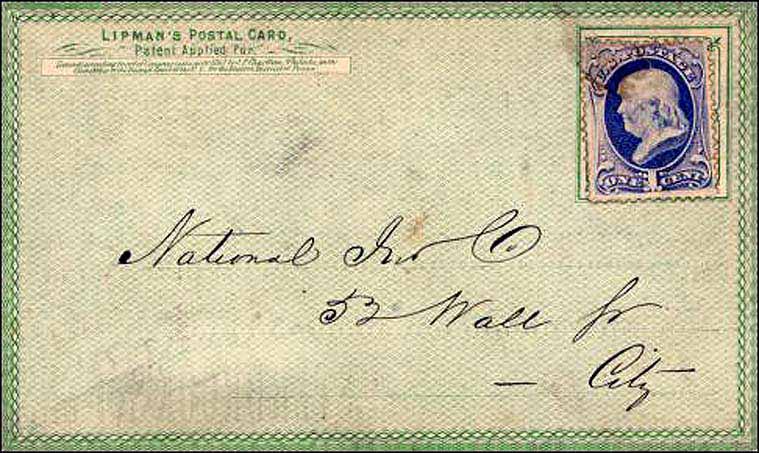
1865
At the Karlsruhe postal conference, Heinrich von Stephan proposed the creation of offenes Postblatt (or, open post-sheets). The goal was to simplify the etiquette of the letter format, but also to reduce the work, paper and costs involved in the sending of a short message.
He suggested the introduction of a rigid card, roughly the size of an envelope, which could be written on and mailed without the need for an envelope, having the postage pre-printed.
The idea was not so well received in Germany: the post office feared the complexity and cost of implementing the scheme in all the different states, each emitting their own stamps.
Despite this setback, Von Stephan was a prominent figure in the history of postal services in Germany. Beginning his work as a postal clerk in 1849, he was successively promoted until he reached the post of Minister of Postal Services in 1895. He focused on the standardization and internationalization of postal services, and later helped establish the Universal Postal Union.
1st October 1869
In Austria-Hungary, Dr. Emanuel Herrmann (a professor of Economics from Vienna) wrote an article in the Neue Freie Presse pointing out that the time and effort involved in writing a letter was out of proportion to the size of the message sent. He suggested that a more practical and cheaper method should be implemented for shorter, more efficient communications.
His recommendations impressed the Austrian Post, who put them to practice on October 1st 1869, resulting in the Correspondenz-Karte, a light-brown 8.5x12cm rectangle with space for the address on the front, and room for a short message on the back. The postcard featured an imprinted 2 Kreuzer stamp on top right corner, costing half the price of a normal letter.
The postcard was born!
It is not known whether Dr. Herrmann had any knowledge of Von Stephan's earlier proposal for a very similar card.
Seeing the immense popularity of this new means of communication, Switzerland, Luxembourg, the United Kingdom and some states of Germany quickly followed suit, issuing postcards less than a year after the initial launch.
Belgium, Holland, Denmark, Finland, Sweden, Norway, and Canada issued cards in 1871, and the following year also Russia, Chile, France, and Algeria added postcards to their offers. In 1873, France, Serbia, Romania, Spain, Japan and the United States issued their own postcard offerings. By 1874, Italy, Romania and Serbia had also began to issue theirs.
1874
The General Postal Union (later renamed Universal Postal Union) was created in Bern, Switzerland. One of its first postal treaties fixed a standard postage for letter mail sent to the members of the Union, and determined that half that rate should be applied to postcards.
This made sending postcards abroad much cheaper, and less complicated.
Today, the UPU is a specialized United Nations agency that coordinates postal policies among its 192 members, standardizing procedures and making international mail delivery much simpler. Prior to its establishment, each country had to organize separate treaties with every single country to engage in international mail delivery with them.
In 1894, twenty years after its inception, an estimated 1.7 billion postcards were exchanged between UPU member countries.
1880s
In the 1880s, many postcards were printed with small sketches or designs (called vignettes) on the message side, initially just in black, but increasingly also in color. Slowly, Germany came to dominate the industry of chromolithography, with many postcards being printed there. A large number of these featured illustrated views of a town and the expression Gruss Aus (or, Greetings from), leaving enough space for a message.
At the end of the decade, the Eiffel Tower made its debut on the Exposition Universelle of 1889 that took place in Paris. French engraver Charles Libonis designed postcards for the occasion featuring the monument, which was the tallest tower in the world at the time. The novelty postcards, which could be mailed from the Eiffel Tower itself, were much beloved by the visitors and became known as Libonis.
1890s
The 1890s saw photography starting to be used in postcards, gradually increasing in popularity over the next few decades. All matter of subjects were photographed with topography (urban street scenes and general views) being a recurrent topic.
At the turn of the century, Kodak launched the No. 3A Folding Pocket camera with negatives that were the same size as postcards, and could thus be printed directly onto postcard card stock without cropping, keeping it simple.
Already in 1854, French photographer Andre Disdéri had patented a version of the photographic carte de visite, which proved to be incredibly popular as visiting cards. They could be reproduced inexpensively and in large quantities, and had space on the back to write a note. Visiting or calling cards could be given out in person or when making social calls, and were incredibly popular in Europe and the United States.
1893
The World's Columbian Exposition opens in Chicago, a world fair where 46 nations participated with exhibitions and attractions. Over 26 million people visited the fair, and for many of them, this was a once-in-a-lifetime chance to discover what lies beyond their own country's borders.
Publisher Charles W Goldsmith seized the opportunity to produce a novelty set of official postcards, showing the pavilions and other interesting sections of the exhibition in color. These were the first commercially produced pictorial postcards to be printed as a souvenir in the United States, and they proved to be a sensational hit.
A year later, prominent London journalist James Douglas wrote:
"Like all great inventions, the Picture Postcard has wrought a silent revolution in our habits. It has secretly delivered us from the toil of letter-writing. There are men still living who can recall the days when it was considered necessary and even delightful to write letters to one's friends. Those were times of leisure. (...) Happily, the Picture Postcard has relieved the modern author from this slavery. He can now use all his ink in the sacred task of adding volumes to the noble collection in the British Museum. Formerly, when a man went abroad he was forced to tear himself from the scenery in order to write laborious descriptions of it to his friends at home. Now he merely buys a picture postcard at each station, scribbles on it a few words in pencil, and posts it. This enhances the pleasures of travel.
Many a man in the epistolary age could not face the terrors of the Grand Tour, for he knew that he would be obliged to spend most of his time in describing what he saw or ought to have seen. The Picture Postcard enables the most indolent man to explore the wilds of Switzerland or Margate without perturbation. "
1897
In June of 1897, the World Association Kosmopolit was founded in Nuremberg, a postcard collecting club with thousands of members. They would send postcards to each other with the greeting Gutferngruß, requesting a return card to be mailed back, thus collecting postcards from all over the world.
The association was active until the First World War, and at its peak counted with more than 15 000 members in Germany alone.
1900-1915
The turn of the century saw the golden era of postcards. An article on the Standard (a British newspaper) from August 21, 1899 read:
"The illustrated postcard craze, like the influenza, has spread to these islands from the Continent, where it has been raging with considerable severity. "
With multiple daily pickups and deliveries (up to 12 times per day in large cities!), postcards were effectively the text messages of their time. It was cheap and convenient to send them, and postcard-obsession reached its peak in the Edwardian era with billions of them being sent every year.
Scenic landscapes, portraits, exhibitions, royal visits, humorous scenes or even current events were quickly printed in postcards shortly after taking place. The many surviving examples of such postcards tell a vivid picture of the time.
On August 21, 1899, an article on the British newspaper Standard read:
"The illustrated postcard craze, like the influenza, has spread to these islands from the Continent, where it has been raging with considerable severity. Sporadic cases have occurred in Britain. Young ladies who have escaped the philatelic infection or wearied of collecting Christmas cards, have been known to fill albums with missives of this kind received from friends abroad; but now the cards are being sold in this country, and it will be like the letting out of waters.(...)"
"Germany is a special sufferer from the circulation of these missives. The travelling Teuton seems to regard it as a solemn duty to distribute them from each stage of his journey, as if he were a runner in a paper chase. His first care on reaching some place of note is to lay in a stock, and alternate the sipping of beer with the addressing of postcards. Sometimes he may be seen conscientiously devoting to this task the hours of a railway journey. Would-be vendors beset the traveller on the tops of hills, and among the ruins of the lowlands, in the hotel, the café and even the railway train. They are all over the country, from one end of the Fatherland to the other, — from the beech woods of Rügen on the North, to the southernmost summit in the Saxon Switzerland. Some of these cards, by the way, are of enormous size; and anyone who is favoured with them by foreign correspondents is subjected to a heavy fine by the inland postal authorities, who are not content with delivering them in a torn and crumpled state."
1902
In 1902, the British Post Office allowed messages to be written on one half of the side normally reserved for the address, paving the way for the divided back era of postcards. This left the reverse side of the card free to be completely filled with an image.
However, these postcards could not be sent abroad until other Universal Postal Union members agreed to do the same. An agreement on the matter was reached at the Sixth Postal Union Congress in Rome, in 1906.
1908
An American of German descent, Curt Teich started a publishing company in Chicago in 1898 focused on newspaper and magazine printing. A few years later, in 1908, Curt Teich Co. introduced postcards to their portfolio, and over the next few decades became the world's largest printer of view and advertising postcards.
Curt Teich was an early pioneer of the offset printing process, and the first to understand the advantages of using lightly embossed paper to speed up the drying of ink, allowing the finished product to retain brighter colors. Because of their texture resembling linen, these embossed postcards became known as linen cards.
He is best known for the Greetings From postcards with large letters, having successfully adapted the idea of the earlier Gruss Aus cards to the US audience.
1908 was also the year in which E. I. Dail, a salesman from Michigan, invented the revolving postcard rack. The metal contraption could be placed in a counter and allowed customers to view and select postcards for themselves.
1913
Starting in 1913 and well into the 1930s, postcards featuring a white border became commonplace in the US.
Typically, multiple postcards were printed in rows on a large sheet of paper, which had to be trimmed around the edges of each postcard — a job that required a great deal of precision. The white borders were introduced to give some margin of error to the process, thus making them less expensive to produce.
1932
The expression carte-maximum (maximum card or maxicard) was first used in 1932, when a collector named Lecestre published an article on Le Libre Échange detailing the design of this philatelic item. A maxicard consists of picture postcard with a postage stamp and a cancellation mark affixed on the picture side of the card. The themes of all these three elements should match in terms of motives, time and location, so that they are in "maximum concordance".
The study, creation and collection of maximum cards is called maximaphily.
2005
On July 14, 2005 Postcrossing was launched!
The website platform was built by Paulo Magalhães, a Portuguese software engineer who loved receiving postcards but did not know many people he could exchange them with. So he coded a website on his free time with the goal of connecting him with other people who also enjoyed sending and receiving postcards. What started as a small side project quickly became a worldwide hobby, shared by many postcard enthusiasts. To date, over 57 million postcards have been exchanged through the platform, with thousands more on the way.
2019
On the 150th anniversary of the postcard, Postcrossing organized a worldwide campaign to celebrate the special occasion.
A postcard contest received thousands of submissions from all over the world sharing their enthusiasm for postcards, filled with kind and thoughtful messages.
A selection of some of the best postcards was showcased during October in an exhibition at the Universal Postal Union headquarters in Bern, Switzerland. More details of the exhibition can be found on Postcrossing's blog.
Many postal operators, museums, libraries and even schools joined the celebrations with postcard related events and initiatives.
Some of the events were:
- 58 meetups
- 11 postcard exhibitions
- 8 special cancellation marks
- 8 workshops
- 6 seminars
- 4 commemorative postcards issued by post offices
- 3 guided tours
- 2 postage stamps
2020
After a successful celebration in 2019 of the 150th anniversary of the postcard, Postcrossing, with the help of Finepaper, decided to launch the World Postcard Day on every October 1st — a day to celebrate the postcard and the connections it brings.
A postcard design contest was organized among design&art students to create an official postcard for the event that was made available for everyone to use on this date.
In the midst of a very unusual year, the special day was nonetheless commemorated all over the world, with the issue of commemorative postcards, dedicated cancellation marks, events in schools, philately fairs, libraries, museums, discounts at post offices and, above all, many many postcards.
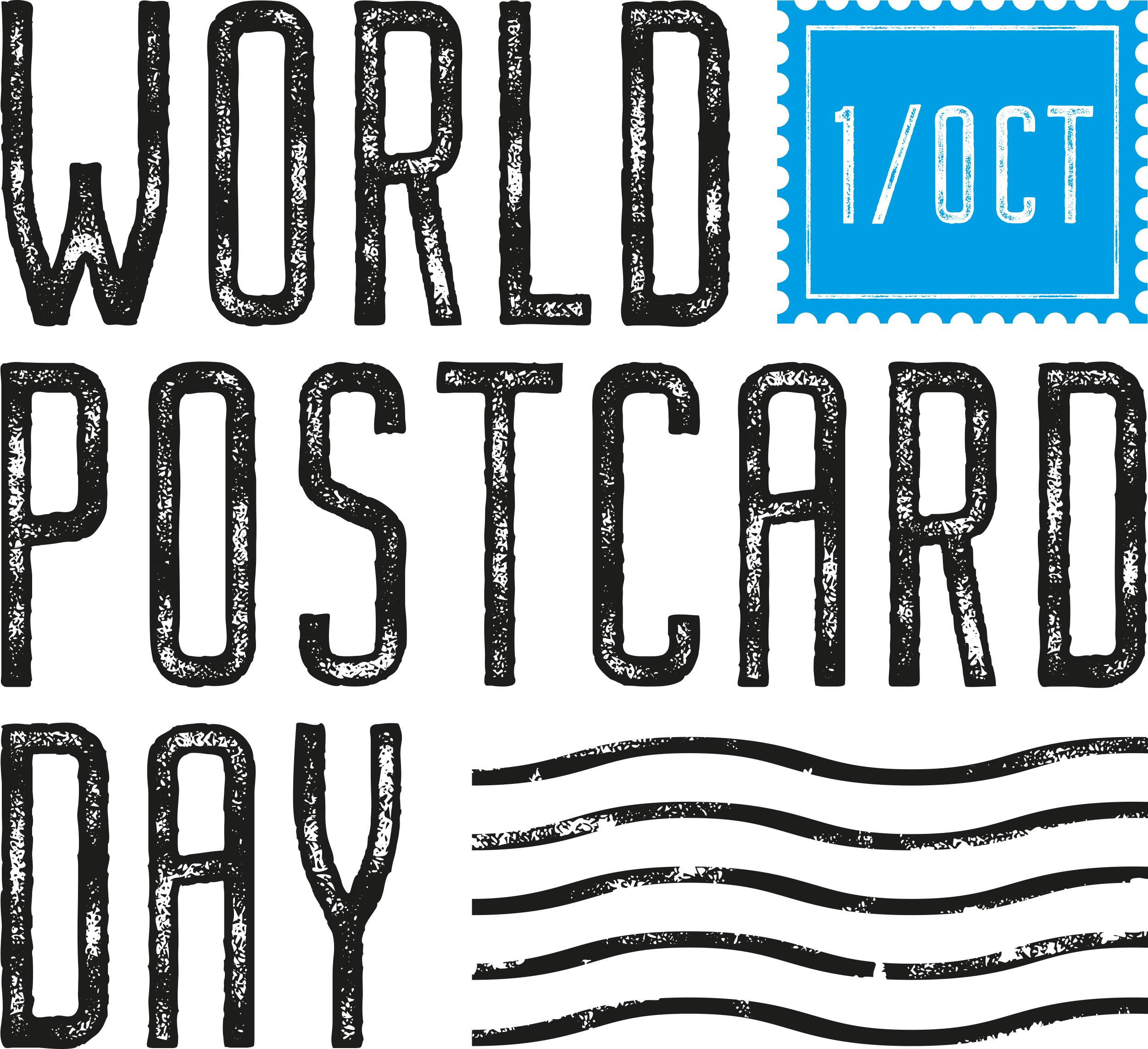
References
- Willoughby, Martin, A History of Postcards (1992), Bracken Books, ISBN 1858911621
- Staff, Frank, The Picture Postcard & Its Origins (1979), Lutterworth Press, ISBN 0718806336
- Hill, C. W., Picture Postcards (1991), Shire Publications Ltd, ISBN 0747803986
- Atkins, Guy, Come Home at Once (2014), Bantam Press, ISBN 9780593074145
- Gruß aus Berlin (1987), Kohler & Amelang, ISBN 3733800087
- Daltozo, José Carlos, Cartão-Postal, Arte e Magia (2006)
- MetroPostcard History of Postcards
- Kosmopolit - Gut Fern Gruss
